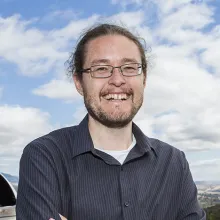Spaced out: Space Scientists in Popular Culture
Since the emergence of the medium film at the beginning of the 20th century, scientists have been populating our cinematic space narratives, visual sci-fi stories and outer space films.
Project status
Content navigation
About
Spaced out: Space Scientists in Popular Culture
Background
Since the emergence of the medium film at the beginning of the 20th century, scientists have been populating our cinematic space narratives, visual sci-fi stories and outer space films. Although they appear in some of the earliest and most influential cultural products (such as Georges Méliès’s 1902 short film A Trip to the Moon) and recent Hollywood blockbusters (such as Ridley Scott’s The Martian), the representation, facets and dynamics of space scientists in popular culture have barely been explored. There has also been a move towards accuracy in space science films, rather than purely fictional settings.
Alongside the serious, if not mad, human scientist who seeks to understand the universe and strives to add their quota to the sum of human knowledge, we also encounter extraterrestrial scientists in popular culture (see Tim Burton’s Mars Attacks! or Neill Blomkamp’s District 9). And we do have comic scientists engaging in space exploration and curious science experiments (such as Rick of Rick and Morty). It is therefore time to revisit the cultural meanings and cultural diversity of space science in popular media, and to put the representation of space research and the portrayal of scientific space exploration in popular culture – beyond their depiction as dubious and threatening – in a more nuanced and contemporary light.
The Project
Popular cultural products – including fictional films and narratives and comic book stories – are vehicles for science communication: they reflect ideas about science and “construct perceptions for both the public and scientists in a mutual shaping of science and culture” (Kirby 2008, 44). Or, more precisely: “Several studies of science popularization demonstrate that its cultural meanings, and not its knowledge, may be the most significant element contributing to public attitudes toward science” / “Popular images of science can significantly influence public attitudes toward it by shaping, cultivating, or reinforcing these ‘cultural meanings’ of science.” (Kirby 2017, 11). Popular images of science are created and propagated in popular entertainment (e.g. circus, see Jürgens 2020) and popular media (e.g. film, Kirby 2014). Science in film, for example, can thus prompt us to “move beyond simplistic notions of science as merely a collection of facts in a textbook and to consider science as a larger cultural institution” (Davies et al 2019, 8).
Against this background, this project will explore the cultural meanings of space science and space scientists in different media since the late 19th century (when moving images emerged as a new medium), above all in film, animated film and comics. It will thoroughly review the literature published around the ‘scientist in space’ theme, including stereotypical depictions of space scientists, including looking at portrayals based on age, gender and race, as well as discover and closely analyse nonthreatening space scientist portrayals (through case studies, using a mixed method qualitative approach – close reading, content analysis, comparative analysis, etc.).
The project will explore (among other questions): What kind of cultural work does the space scientist do in cultural contexts (for example in the form of comic science aliens or female astronauts)? What scientists, and based on what characteristics, have produced nonthreatening, positive cultural fantasies? What do camp and clown-space scientists look like? What can we learn from comic space science, whether funny or not, about science? What does comic performance offer in understanding cultural ideas and public images of space science? What influence can space exploration and science as portrayed in comics and animated film (etc.) have on science?
By focusing on role of humour and comic performance in shaping the cultural representation – or cultural meanings – of the space scientist character and their associated scientific domain, this project directly responds to the fact that cultural narratives about laughter and comedy have been barely discussed in science communication and related fields, despite a growing interest in humorous public science events, science stand-up routines or science-based sitcoms (see Riesch, 2015). More so, this project has the potential to make a difference to the discipline itself, not just by producing new knowledge, insights and deeper understanding, but also because it can help develop a more nuanced, contemporary understanding of what space science is in culture (and what ‘space scientific storytelling’ may be defined).
Eligibility
Admission to a Doctor of Philosophy degree at ANU requires:
- An Australian Bachelor degree with at least Second Class or its international equivalent, or
- Another degree with a significant research/thesis component that may be assessed as equivalent to paragraph (1), or
- A combination of qualifications, research publications and/or professional experience related to the field of study that may be assessed as equivalent to paragraph (1).
Further information relating to eligibility can be found on the ANUs website: http://www.anu.edu.au/study/apply/anu-postgraduate-research-domestic-and-international-applications
The Candidate
The successful applicant will have a passion for science in popular culture, particularly space science/astronomy, and for interdisciplinary research – because this project will require bridging the humanities (studying fictional texts, popular entertainment and popular media (such as films and comics)), science communication (exploring the representation and cultural meanings of a science discipline in popular culture) and sciences (astronomy). They will have a background in a relevant discipline (ideally astronomy, or, alternatively, science communication or cultural studies) and an advanced awareness/knowledge of humanities research methods. They will also possess strong interpersonal skills, curiosity, strong writing skills, and be able to work effectively as part of a small interdisciplinary team and also independently. If the applicant has a background in the humanities, a very strong commitment to understanding and working with scientific concepts (astronomy) is expected.
Supervisors
Dr Anna-Sophie Jürgens, Popular Entertainment Studies, Australian National Centre for the Public Awareness of Science, ANU
Dr Brad Tucker, Astronomy/Astrophysics and Cosmology, Research School of Astronomy and Astrophysics, ANU
Funding
The successful applicant with be based in the Australian National Centre for the Public Awareness of Science (CPAS) at the ANU. Scholarships are available for both domestic and international applicants, and CPAS will work with the successful applicant to guide them through the scholarship process.
To Apply
To be considered for this position, in the first instance please forward a current CV (2-page max.) and short cover letter (1-page max.) to Dr Anna-Sophie Jürgens (anna-sophie.jurgens@anu.edu.au) and Dr Brad Tucker (brad@mso.anu.edu.au). In the cover letter, be sure to let us know why you are the perfect candidate based on the skills outlined above. Shortlisted candidates will then be invited to Zoom to discuss their applications further.
Applications will be assessed on a rolling basis as they are received, and this position will remain open until filled.
Further Reading
Davies, S R, Halpern, M, Horst, M, Kirby, D A, Lewenstein, B (2019): “Science stories as culture: Experience, identity, narrative and emotion in public communication of science”, JCOM 18/05, A01.
Flicker, E (2003): “Between Brains and Breasts: Women Scientists in Fiction Film: On the Marginalization and Sexualization of Scientific Competence”, Public Understanding of Science 12, 307-318.
Frayling, C (2006): Mad, Bad and Dangerous?: The Scientist and the Cinema, London: Reaktion Books.
Haynes, R D (2017): From Madman to Crime Fighter: The Scientist in Western Culture, Baltimore: Johns Hopkins UP.
Johnston, K M (2011): Science Fiction Film: A Critical Introduction, London: Bloomsbury.
Jürgens, A-S (accepted for publication July 23, 2020): “Being the Alien: The Space Pierrots and Circus Spaces of David Bowie, Klaus Nomi and Michael Jackson”, Southern Space Studies: Outer Space and Popular Culture 2, ed. by Annette Froehlich, Cham: Springer.
Jürgens, A-S, and S. Chiodo (2020): “'Greatest Klown on Earth' – and the Killer Klowns from Outer Space. Stephen Chiodo in conversation with Anna-Sophie Jürgens”, Comedy Studies 11/1, 133-141.
Jürgens, A-S (2020): “Clowns in Space: An Introduction to Circus Aliens and Spaced-out Comic Performers”, Southern Space Studies: "Outer Space and Popular Culture: Influences and Interaction", ed. by Annette Froehlich, Springer: Cham, 71-89.
Jürgens, A-S (Ed.) (2020): Circus, Science and Technology. Dramatising Innovation, Cham: Palgrave Macmillan.
Jürgens, A-S (2020): “Side-splitting amusement: On comic scientists – the sciency type of violent clowns?“ Comedy Studies 11/1, 121-132.
Kirby, D (2008): “Cinematic Science”, in Bucchi, M, Trench, B (eds.), Handbook of Public Communication of Science and Technology, New York: Routledge, 41-57.
Kirby, D (2014): “Science and Technology in Film: Themes and Representations”, in Bucchi, M, Trench, B (eds.) Handbook of Public Communication of Science and Technology, New York: Routledge, 97-112.
Kirby, D (2017): “The Changing Popular Images of Science”, in Jamieson, K H, Kahan, D M, Scheufele, D A (eds.) The Oxford Handbook of the Science of Science Communication, Oxford Handbooks Online.
Menville, D A, and R. Reginald (1977): Things to Come: An Illustrated History of the Science Fiction Film, New York: Times Books.
Riesch, H (2015): “Why did the proton cross the road? Humour and science communication”, Public Understanding of Science 24/7, 768-775.
Steinke, J (2005): “Cultural Representations of Gender and Science: Portrayals of Female Scientists and Engineers in Popular Films”, Science Communication 27/1, 27-63.


